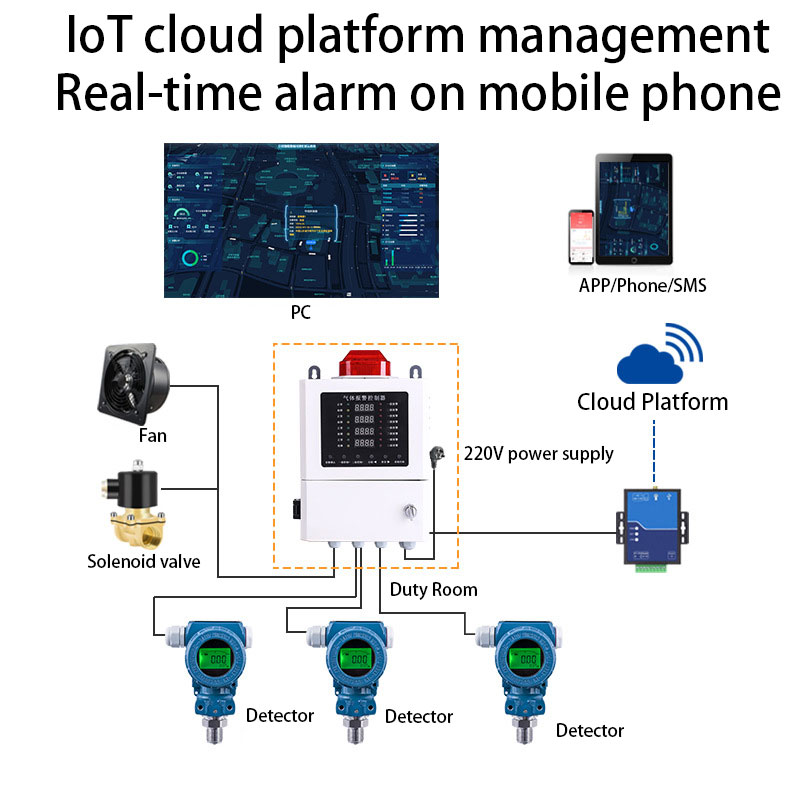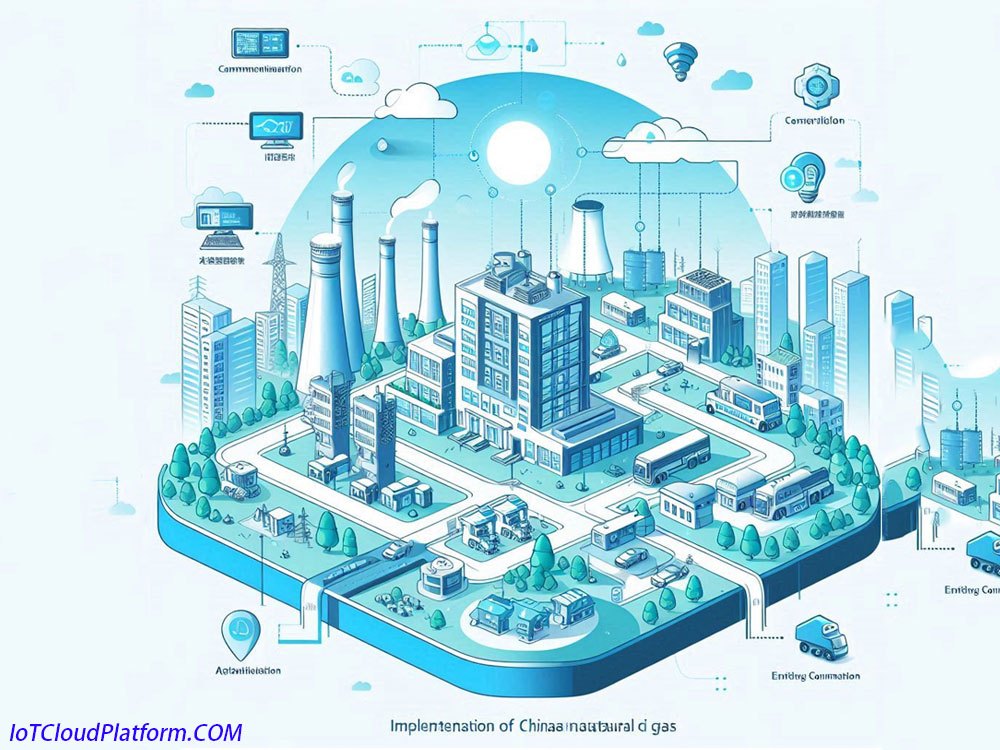
How to Implement China’s Natural Gas IoT Solutions?
Implementing China’s natural gas IoT solution is a complex and systematic project, which involves multiple links in the natural gas industry, including production, transmission, storage, metering, use and marketing.
The following is a detailed introduction and key points on how to implement China’s natural gas IoT solution.
Introduction
As a clean and efficient energy source, natural gas plays an increasingly important role in modern society. However, the natural gas industry also faces many challenges, such as aging pipelines, poor energy consumption management, and safety hazards. In order to solve these problems and improve the operational efficiency and management level of the natural gas industry, it is particularly important to implement the natural gas IoT solution.
Overview of Natural Gas IoT Solution
The natural gas IoT solution refers to the intelligent transformation and upgrading of various links in the natural gas industry through the Internet of Things technology, so as to achieve comprehensive coverage of data collection, transmission, analysis and application.
The solution includes four parts: perception layer, network layer, platform layer and application layer, which are responsible for data collection, data transmission, data processing and application services respectively.
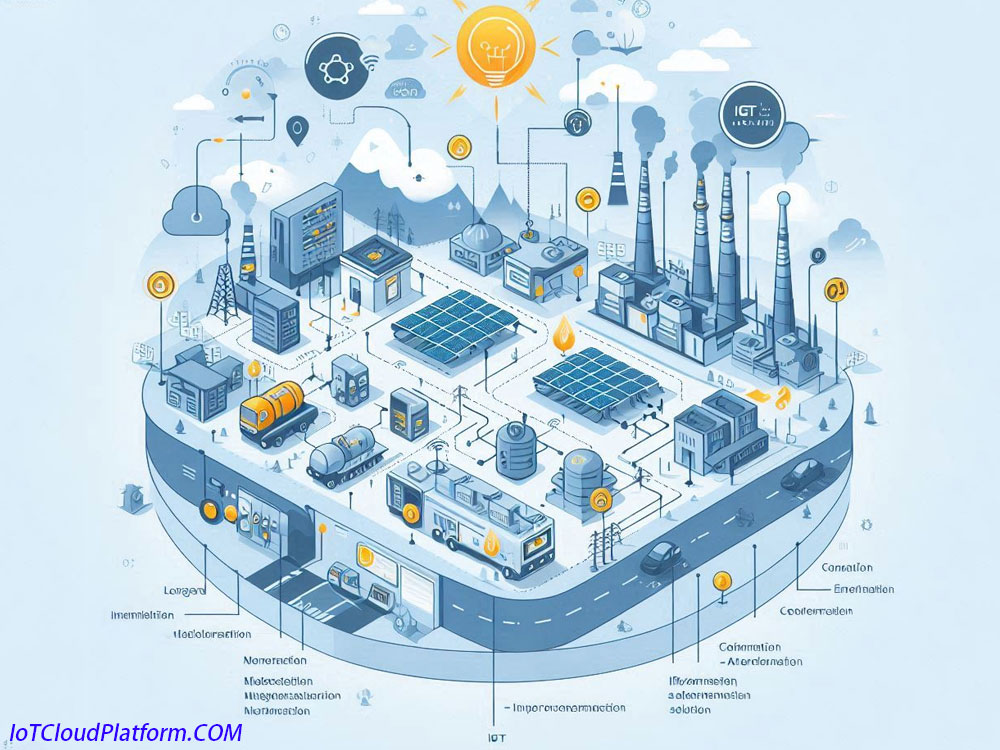
Implementation steps
Demand analysis
Before implementing the natural gas IoT solution, it is necessary to first conduct an in-depth analysis of the actual needs of the natural gas industry. This includes understanding the business processes, operating models, safety supervision requirements, and customer needs of the natural gas industry. Through demand analysis, the specific problems that the IoT solution needs to solve and the goals to be achieved can be clarified.
Technology selection
According to the results of demand analysis, choosing the right technology and tools is the key to realizing the natural gas IoT solution. This includes sensor technology, communication technology, cloud computing platform, big data analysis technology, etc. Sensor technology is used to collect data from all aspects of the natural gas industry; communication technology is used to transmit the collected data to the data center in real time; cloud computing platform provides data storage, processing and computing capabilities; big data analysis technology is used to mine and analyze massive data and provide decision support.

System design
System design is the core link of the natural gas IoT solution. It needs to design an IoT system that meets the characteristics of the natural gas industry and can meet actual needs based on the results of demand analysis and technology selection. System design includes system architecture design, database design, interface design, user interface design, etc. In the design process, factors such as system scalability, stability and security need to be fully considered.
Development and testing
After the system design is completed, system development and testing are required. The development phase includes writing code, debugging programs, integrating various modules, etc. The testing phase requires functional testing, performance testing, and security testing of the system to ensure that the system can operate normally and meet the design requirements.

Deployment and Implementation
After the system development and testing are completed, the system deployment and implementation work needs to be carried out. This includes installing the system in various links of the natural gas industry, and carrying out equipment debugging, data configuration, etc. At the same time, relevant personnel need to be trained to ensure that they can use the new Internet of Things system proficiently.
Maintenance and Optimization
After the system deployment and implementation are completed, the system maintenance and optimization work needs to be carried out. This includes regular inspection, maintenance, and upgrade of the system to ensure that the system can operate continuously and stably. At the same time, the system performance needs to be monitored and optimized to improve the system’s operating efficiency and service quality.
Key Technology Application
Sensor Technology
Sensor technology is one of the basic technologies in the natural gas Internet of Things solution. It provides real-time and accurate information for the Internet of Things system by collecting data from various links in the natural gas industry. In the natural gas industry, commonly used sensors include temperature sensors, pressure sensors, flow sensors, etc. These sensors can monitor the temperature, pressure, flow and other parameters of natural gas pipelines in real time, and provide data support for the operation and management of the system.
Communication technology
Communication technology is one of the key technologies for realizing natural gas IoT solutions. It is responsible for transmitting the data collected by the sensors to the data center in real time, providing data support for the subsequent processing and analysis of the system. In the natural gas industry, commonly used communication technologies include wired communication and wireless communication. Wired communication, such as optical fiber communication and Ethernet communication, has the advantages of fast transmission speed and good stability; wireless communication, such as GPRS, LoRa, NB-IoT, has the advantages of wide coverage and flexible deployment. Choosing appropriate communication technology according to actual needs can ensure the real-time and accuracy of data.
Cloud computing platform
The cloud computing platform is an important part of the natural gas IoT solution. It provides data storage, processing and computing capabilities, providing strong support for the operation and management of the IoT system. In the natural gas industry, the cloud computing platform can realize the storage and management of massive data, while providing data analysis and mining functions to support the decision-making of enterprises. In addition, the cloud computing platform can also realize integration and interoperability with other systems to improve the scalability and flexibility of the system.
Big data analysis technology
Big data analysis technology is one of the key technologies in the natural gas IoT solution. It mines and analyzes massive data to discover the laws and trends in the data and provide support for corporate decision-making. In the natural gas industry, big data analysis technology can be applied to energy consumption monitoring, fault warning, production optimization and other aspects. Through big data analysis technology, comprehensive monitoring and management of the natural gas industry can be achieved to improve operational efficiency and safety.
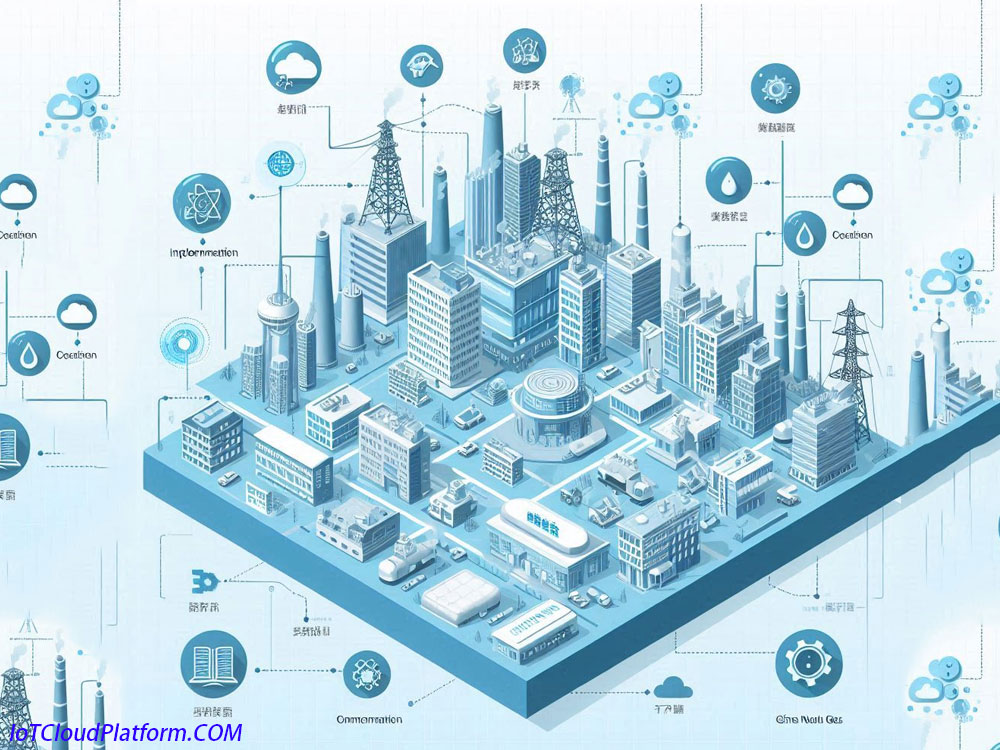
Application scenarios and benefit analysis
Natural gas pipeline monitoring
Natural gas pipelines are an important part of the natural gas industry, and their safety and stability are directly related to the operating efficiency and safety of the entire industry. Through IoT technology, real-time monitoring and early warning of natural gas pipelines can be achieved. For example, temperature sensors, pressure sensors, flow sensors and other equipment are installed on the pipeline to monitor the temperature, pressure and flow of the pipeline in real time. When the parameters are abnormal, the system will issue early warning information in time to remind relevant personnel to deal with it. This can greatly improve the safety and stability of natural gas pipelines and reduce the occurrence of safety accidents.
Natural gas energy consumption monitoring
Natural gas energy consumption monitoring is one of the important application scenarios in the natural gas IoT solution. By accessing data collected by sensors such as flow meter data, real-time collection and monitoring management of natural gas energy consumption can be achieved. The system can display information such as energy consumption data and energy consumption time of each device to help users detect abnormal losses in time and take measures. This can not only improve energy utilization efficiency and reduce energy consumption costs, but also provide support for the company’s energy conservation and emission reduction work.
Natural gas sales data analysis
With the intensification of market competition, natural gas companies need to strengthen the management of sales links. Through the Internet of Things technology, real-time analysis and prediction of sales data can be achieved. The system can collect and analyze sales data to help companies better grasp market trends and customer needs. This can provide a basis for companies to formulate reasonable sales strategies and improve market competitiveness.
Natural gas production optimization
The natural gas production process involves a large number of equipment and pipelines, and their operating status needs to be monitored in real time to ensure production safety. At the same time, the production process can be optimized and output can be increased through the analysis of production data. Internet of Things technology can realize remote monitoring and maintenance of equipment and reduce the cost of manual inspections. In addition, through data analysis, bottlenecks and problems in the production process can be discovered and corresponding measures can be taken to optimize them. This can improve production efficiency, reduce operating costs and create more value for enterprises.
Challenges and Countermeasures
Technical Challenges
In the process of implementing natural gas IoT solutions, technical challenges are an issue that cannot be ignored. Due to the particularity and complexity of the natural gas industry, the application of IoT technology needs to fully consider factors such as its security and stability. In addition, the compatibility and interoperability between different devices and systems is also a problem that needs to be solved. In order to solve these technical challenges, it is necessary to strengthen technical research and development and innovation to improve the technical level; at the same time, strengthen standardization work to formulate unified technical standards and specifications.
Data Security Challenges
Data security is one of the important issues in natural gas IoT solutions. Since the IoT system involves a large amount of sensitive data and privacy information, effective security measures need to be taken to ensure the security and privacy of data. This includes strengthening data encryption and transmission security; at the same time, establishing a sound access control mechanism and identity authentication system to prevent unauthorized access and operation.
Talent Shortage Challenges
The implementation of natural gas IoT solutions requires professional technical talents to support. However, the natural gas industry is currently facing a shortage of talents, especially professionals in IoT technology. In order to solve this problem, it is necessary to strengthen talent training and introduction; at the same time, strengthen cooperation with universities and research institutions to cultivate more professional talents to provide strong talent guarantee for the development of the industry.
Conclusion and Outlook
Implementing China’s natural gas Internet of Things solution is an important way to improve the operational efficiency and management level of the natural gas industry. Through the application of Internet of Things technology, comprehensive monitoring and management of the natural gas industry can be achieved to improve safety and stability; at the same time, optimize the production process to reduce operating costs and create more value for the enterprise.
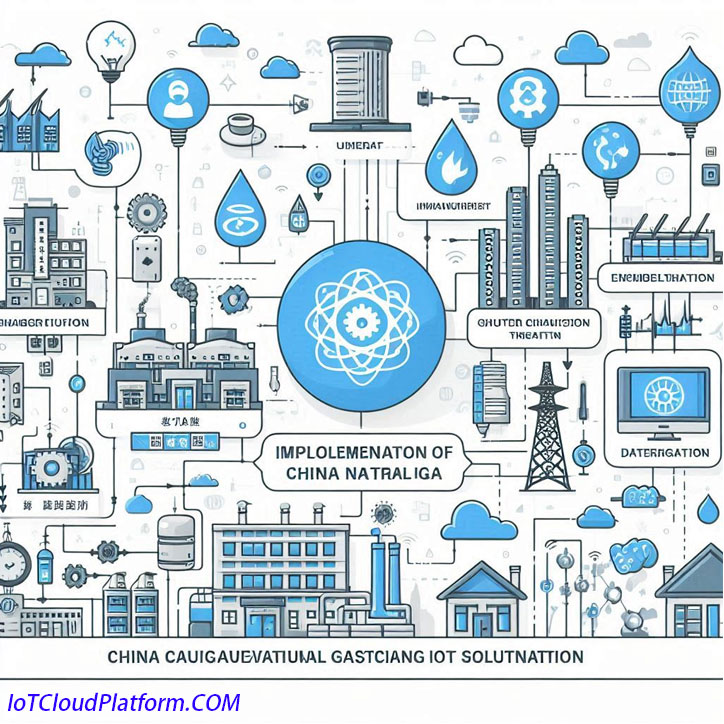
However, there are also some challenges in the implementation process, such as technical challenges, data security challenges and talent shortage challenges. In order to solve these problems, it is necessary to strengthen technology research and development and innovation; strengthen standardization work; establish a sound security mechanism and access control system; strengthen talent training and introduction efforts to promote the smooth implementation and development of natural gas Internet of Things solutions.
With the continuous development and improvement of Internet of Things technology and the continuous application and promotion of Internet of Things technology in the natural gas industry, it is believed that China’s natural gas Internet of Things solution will be more widely used and developed in the future.
This will provide strong support for the digital transformation and intelligent upgrading of the natural gas industry and promote the sustainable development and progress of the industry.
IoT Cloud Platform Solutions
IoT Cloud Platform (blog.iotcloudplatform.com) is committed to IoT technology, including industrial IoT, agricultural IoT, natural gas IoT, meteorological IoT, meta-computing IoT, big data IoT, security IoT, military IoT, medical IoT and other technical research.
IoT Cloud Platform (blog.iotcloudplatform.com) provides you with the implementation of China Natural Gas IoT solution. We are experts in the IoT industry, with decades of experience in IoT data research and IoT programming development. Blog.iotcloudplatform.com has an IoT creative research team, dedicated to project creative research and development in the field of IoT.
At the same time, we have professional IoT writing experts to write IoT technology solutions for your IoT enterprise, implement solution plans, and implement IoT marketing solutions. We are China IoT digital marketing experts, and the team technicians include digital marketing, Google SEO research experts, IoT engineers, and IoT trend analysis research experts. If you need to carry out your IoT project, or conduct digital marketing promotion for your IoT project, please contact us.
FAQs about the implementation of China Natural Gas IoT solutions
The natural gas IoT solution refers to a system that uses technologies such as the Internet of Things, cloud computing, and big data to achieve remote operations such as real-time collection of gas flow information, equipment status monitoring, and control command issuance.
The main functions include real-time collection of gas flow information, monitoring of equipment status, and remote operations such as issuing control commands, as well as user services such as prepaid billing, valve closing reminders, and remote payment.
Users can recharge and pay on-site through online payment platforms such as Alipay and WeChat, or at designated convenience stores, natural gas company management stations, etc. After recharging, the gas meter will automatically interact with the background system to update the meter balance.
Common fault codes include E-1003 (forced valve closure, insufficient balance or arrears), E-1007 (low built-in lithium battery), E-4002/E-4044 (low alkaline battery or power failure), E-6025 (valve closure after preset gas volume is used up) and E-6023 (valve failure).
The solution detects and handles safety hazards in a timely manner by monitoring gas flow and equipment status in real time. At the same time, when users encounter a gas meter valve closure and need to reopen the valve, they should ensure that all gas appliances are closed to prevent accidents. Once a gas leak occurs, the valve in front of the meter should be closed immediately, the doors and windows should be opened for ventilation, and a phone call should be made in an outdoor safe area.
The implementation of the solution can improve the level of modernization of urban management, detect and handle safety hazards in a timely manner through real-time monitoring and data analysis, and reduce the probability of accidents. At the same time, it can also intelligently adjust the supply according to fluctuations in gas demand to improve the efficiency of resource use.
When carrying out digital marketing, China’s natural gas IoT solution can focus on the following aspects:
Build a digital platform:
Establish digital channels such as official websites and mobile applications to display detailed information, technical advantages and application cases of natural gas IoT solutions.
Use digital platforms to provide convenient customer services, such as online consultation, appointment installation, fault reporting, etc., to improve user experience.
Use social media marketing:
Register official accounts on social media platforms such as Weibo, WeChat, and Douyin to publish industry information, technical trends, product introductions and other content to attract user attention.
Through social media interactions, such as comment replies and private message communication, strengthen contact with users and understand user needs.
Carry out search engine optimization (SEO):
Optimize the ranking of the official website in search engines to ensure that users can find and click in when searching for relevant keywords.
Use search engine advertising (such as Baidu bidding ranking) to increase the exposure and click-through rate of the website.
Use big data analysis:
Collect user behavior data on digital platforms, such as browsing history, clicks, stay time, etc., and conduct in-depth analysis.
According to the results of data analysis, accurately push personalized content and services to improve user conversion rate and satisfaction.
Cooperation and resource integration:
Establish cooperative relationships with upstream and downstream enterprises, industry associations, scientific research institutions, etc., and jointly promote natural gas Internet of Things solutions.
Integrate resources from all parties, such as technology, capital, market, etc., to form a joint force and enhance market competitiveness.
Online and offline integration:
Combine offline physical channels, such as exhibitions, seminars, customer activities, etc., to promote natural gas Internet of Things solutions.
Improve user participation and trust through online and offline interactions, such as online appointments for offline experiences, and online live broadcasts of offline activities.
